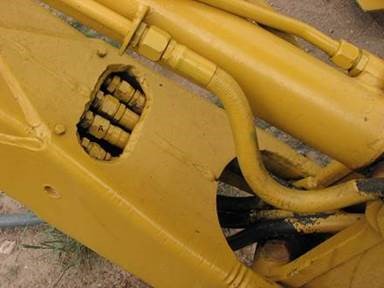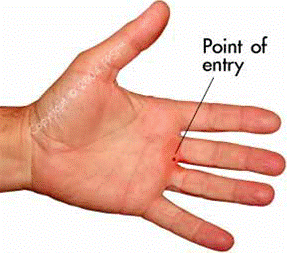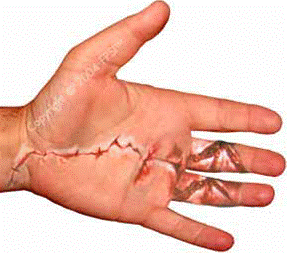Leaks of hydraulic oil are one of the most common releases of oil that occur due to our work. Although these releases tend to be low volume, they are still significant in that the released oil typically impacts soil which then requires containment and disposal. Hydraulic systems operate under very high pressure (>2,000 psi) which, when improperly maintained, can cause H&S issues. In addition, the piece of equipment that experienced the leak frequently requires immediate repair which means it cannot be used for its intended purpose. Accordingly it is in everyone’s best interest to minimize the frequency of such incidents.
The above figure shows a section of a backhoe boom. As indicated in the figure, hydraulic systems have numerous connection points where a leak could occur. In addition the hoses flex and rub which can also lead to leakage. Due to the wide variety of stresses placed on hydraulic hoses (abrasion, dirt, UV, fluctuating pressure, temperature, flex, torsion, etc.) these hoses have a finite life. Good practice involves not using hoses that are older than10 years from the date of manufacture. Hydraulic hoses on construction equipment frequently have a lifespan on the order of six years of use. Hoses that are at or beyond the end of their expected lifespan must be frequently inspected and/or replaced.
Inspections
In general, hydraulic systems should be inspected every 400-600 hours of operation. This is a detailed inspection that goes beyond the daily operational checks. The company that furnishes the equipment must have in place a comprehensive inspection program for all hydraulic equipment and Stratus Workforce is required to review these documents prior to accepting the use of the equipment. Hoses and connections that fail the inspection must be replaced.
Equipment that is in the field must be inspected at delivery, on a daily basis, and when leaks occur. In addition, the area where the work will occur must be evaluated prior to starting work to verify that there are no objects (e.g. partially buried pipes or exposed rebar) which could physically damage the equipment during operation. The company that operates the equipment must have a procedure for daily inspections. Due to the aforementioned stresses and strains on a hydraulic hose, their construction is more complex than meets the eye. High pressure hydraulic hoses have an inner plastic tube, one or more braided steel layers and finally an outer wear layer. Leaks in the inner tube are evidenced by flow either through the outer layer or at a coupling which, in some cases, may not be at the location of the leak in the inner tube. This effect combined with the slow nature of many of these leaks can make it difficult to locate a leak in a hydraulic line.
Field personnel should not run their hands over a hydraulic line where there is a suspected leak particularly when it is under pressure but, when necessary, should use a long piece of cardboard or a broom as this greatly reduces the risk of a pinhole leak injecting hydraulic fluid into a person’s hand under pressure. Although this is a rare injury, it is extremely dangerous and improperly treated can lead to amputation. Because the injury is so rare and initially not overly painful, it is frequently misdiagnosed or underestimated. When such an injury is suspected, it is recommended that the injured person be transported directly to a hospital instead of an emergency care clinic. The injured person will need to be very clear about what happened and be prepared to go directly to surgery.
Summary
The primary means by which these leaks can be minimized is through proper inspection and replacement, when required, of the hydraulic systems. When inspecting these systems, personnel need to be aware that they operate under high pressure and work to minimize risk accordingly. In addition, risks posed by the environment need to be minimized through careful planning prior to starting the work.



